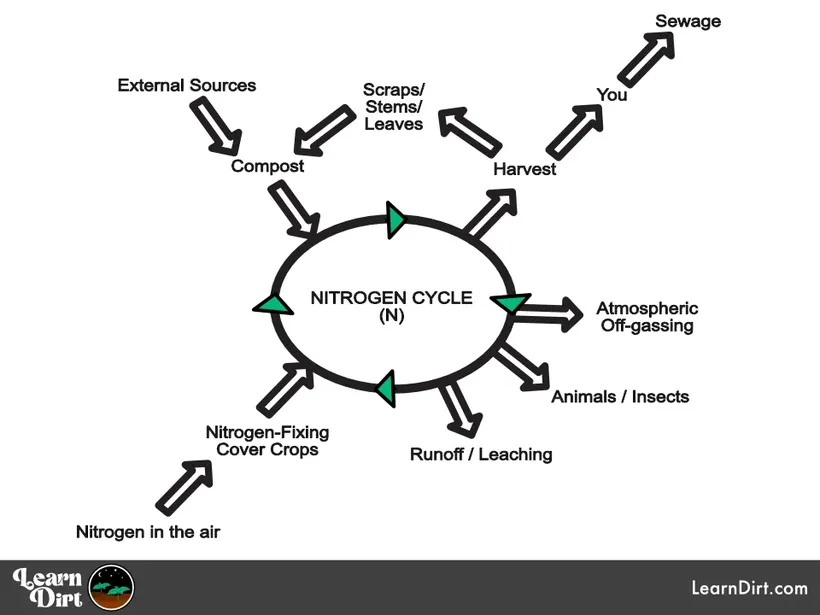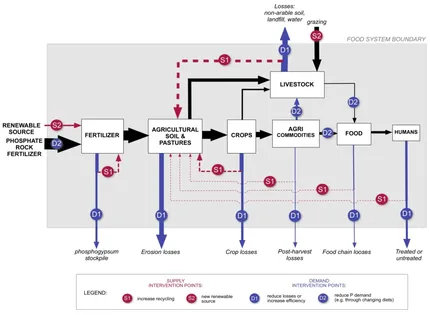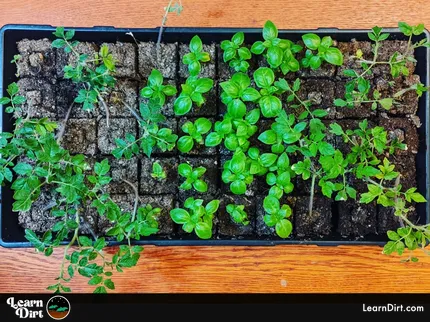Table of Contents
* Our articles never contain AI-generated slop *
Nitrogen is crucial for food production, especially for vegetative growth. Let's look at how it cycles through agricultural systems.
Organic Sources of Nitrogen
Nitrogen comprises roughly 78% of our atmosphere here on Earth. If you're not on Earth, your results may vary.
That's great news for anyone who wants to grow plants, because it means that there's literally no reason to ever buy synthetic commercial sources of Nitrogen.
Disclaimer: This post may contain affiliate links. Refer to the privacy policy for more information.
It's free in the air, you just need to harvest it.
Let's look at The Nitrogen Cycle to see how nitrogen circulates through organic agroecosystems:

This cycle diagram is drawn with gardeners in mind, but can be scaled to fit any regenerative agriculture system. Simply replace "you" as an outflow of Nitrogen with "consumers" if you're growing in a commercial setting.
Additional pieces may be plugged into this cycle, such as biodigesters and livestock. The important part is that you can envision how this essential nutrient cycles through your agricultural system.
Understand the inflows and outflows of nitrogen so you can mitigate nitrogen loss and focus on nitrogen accumulation over time. This is one of the tenets of a regenerative system.
Accumulating nitrogen over time is an organic a cost-effective way to fertilize your plants. It also builds your soil without dumping money into synthetics and trashing the ecosystem.
Join The Grower's Community
Looking for a place to meet growers,
ask questions, share knowledge, be heard,
and feel like you belong? 🌱
Check It Out!
In larger agricultural systems it often becomes untenable to provide all the nitrogen necessary for plant growth through compost alone.
Purchasing compost, manure, hay, mulch, and amendments also stop being cost-effective as agricultural systems grow larger. You may be able to fill some planters or a raised bed or two with homemade compost and bagged manure, but you'll likely be unable to scale that to an entire yard or farm.
For all these reasons and more, we turn towards nitrogen-fixing cover crops as the most cost-effective and scalable way to add nitrogen to our agroecosystems.
Nitrogen-fixing cover crops are THE means by which your garden can extract nitrogen directly from the air, and get it into the soil.
In other words, nitrogen-fixing cover crops are pure gold. The kind of gold that completely removes your reliance on chemical companies, wasting money buying ammonium nitrate at exorbitant cost while destroying your groundwater and ecosystem.
Synthetic sources of nitrogen becomes unnecessary and completely ridiculous once you understand how cover cropping works within the context of the nitrogen cycle.
Let's look at some common nitrogen-fixing cover crops you can utilize to add nitrogen to your soil and power your garden or farm...
Common Nitrogen-Fixing Cover Crops
Each of the cover crops listed here will act as a net-positive nitrogen input for your soil, when chopped and dropped frequently or at the end of their growth cycle:
- Alfalfa
- Beans (Dry, Fava / Broad)
- Buckwheat
- Clover (Red, White, Crimson, Subterranean, etc.)
- Cowpea
- Fenugreek
- Lespedeza (Korean, Sericea)
- Lupin
- Pea (Field, Forage, Sweet, Winter)
- Sesbania
- Soybean
- Sunn Hemp
- Sweet Clover (Yellow, White)
- Trefoil
- Vetch (Common, Hairy, Woolypod)
Some of these crops produce more nitrogen than others, and grow during different seasons and in differing conditions. I encourage you to both research and trial many different nitrogen-fixers and find what works for you in your microclimate.
Problems With Synthetic Nitrogen
Chemical gardeners often turn to liquid and crystalline forms of synthetic nitrogen such as ammonium nitrate and calcium nitrate.
For synthetic home gardeners, Miracle Gro is the cheap go-to which usually occupies this role.
Synthetic forms of nitrogen tend to be incredibly water-soluble. This means they have a tendency to leech into groundwater and run into streams and rivers.
Downstream from chemical agriculture, ecosystems become polluted and can cause significant die-offs of all manner of native fauna. Fish and invertebrates are particularly vulnerable to chemical fertilizer pollution.
We see eutrophication of freshwater sources when too much synthetic nitrogen leeches in. Algae and phytoplankton can explode, throwing the delicate ecosystem balance off completely. Human-induced eutrophication costs an estimated 2.2 billion dollars annually in damages - but the true cost of ecosystem collapse is more than just monetary.
Additionally, synthetic nitrogen causes serious long-term degradation of soil microbiomes.
Finally, only an estimated 50% of applied synthetic nitrogen fertilizer even reaches the roots of most plants. Half of the money you spend is literally washed into the nearest waterway.
That's all for now, thanks for reading!
If you have any questions, comments, or would like to connect with fellow gardeners, head on over to the forum and post there.













![Black Dirt Live Again [Green] T-shirt](/media/product_images/black-dirt-live-again-[green]_shirt_260x260.png)







